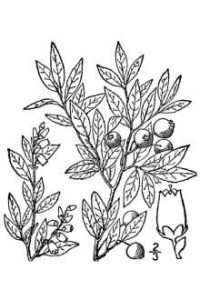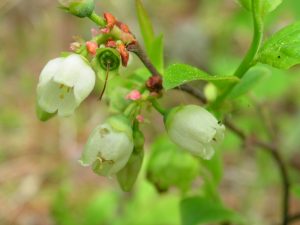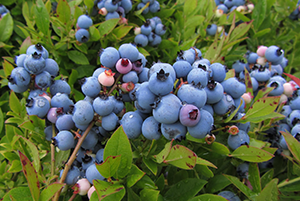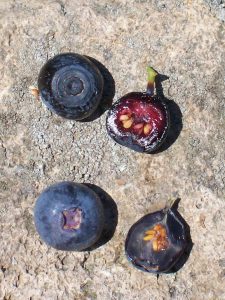Lowbush Blueberry Phenophase Definitions

Directions: As you report on phenophase status (Y, N, or?) on the datasheets, refer to the definitions on this sheet to find out what you should look for, for each phenophase in each species. To report the intensity of the phenophase, choose the best answer to the question below the phenophase, if one is included.
Leaves
Breaking leaf buds: One or more breaking leaf buds are visible on the plant. A leaf bud is considered “breaking” once a green leaf tip is visible at the end of the bud, but before the first leaf from the bud has unfolded to expose the leaf stalk (petiole) or leaf base.
How many buds are breaking?
Less than 3; 3 to 10; 11 to 100; 101 to 1,000; 1,001 to 10,000; More than 10,000.
Leaves: One or more life, unfolded leaves are visible on the plant. A leaf is considered “unfolded” once its entire length has emerged from a breaking bud, stem node or growing stem tip, so that the leaf stalk (petiole) or leaf base is visible at its point of attachment to the stem. Do not include fully dried or dead leaves.
What percentage of the potential canopy space is full with leaves? Ignore dead branches in your estimate of potential canopy space.
Less than 5%; 5-24%; 25-49%; 50-74%; 75-94%; 95% or more.
Increasing leaf size: A majority of leaves on the plant have not yet reached their full size and are still growing larger. Do not include new leaves that continue to emerge at the ends of elongated stems throughout the growing season.
What percentage of full size are most leaves?
Less than 5%; 5-24%; 25-49%; 50-74%; 75-94%; 95% or more.
Colored leaves: One or more leaves show some of their typical late-season color, or yellow or brown due to drought or other stresses. Do not include small spots of color due to minor leaf damage, or dieback on branches that have broken. Do not include fully dried or dead leaves that remain on the plant.
What percentage of the potential canopy space is full with non-green leave color? Ignore dead branches in your estimate of potential canopy space.
Less than 5%; 5-24%; 25-49%; 50-74%; 75-94%; 95% or more.
Falling leaves: One or more leaves are falling or have recently fallen from the plant.
Flowers

Flowers or flower buds: One or more fresh open or unopened flowers or flower buds are visible on the plant. Include flower buds or inflorescences that are swelling or expanding, but do not include those that are tightly closed and do not actively growing (dormant). Also do not include wilted or dried flowers.
How many flowers or flower buds are present?
Less than 3; 3 to 10; 11 to 100; 101 to 1,000; 1,001 to 10,000; More than 10,000.
Open flowers: One or more open, fresh flowers are visible on the plant. Flowers are considered “open” when the reproductive parts (male stamens or female pistils) are visible between or within unfolded or open flower parts (petals, floral tubes or sepals). Do not include wilted or dried flowers.
What percentage of all fresh flowers (buds plus unopened plus open) on the plant are open?
Less than 5%; 5-24%; 25-49%; 50-74%; 75-94%; 95% or more.

Fruit
Fruits: One or more fruits are visible on the plant. For Vaccinium angustifolium, the fruit is a juicy berry that changes from green to pinkish-green to purplish to deep blue, sometimes with a whitish powdery film.
How many fruits are present?
Less than 3; 3 to 10; 11 to 100; 101 to 1,000; 1,001 to 10,000; More than 10,000.
Ripe fruits: One or more ripe fruits are visible on the plant. For Vaccinium angustifolium, a fruit is considered ripe when it has turned deep blue, sometimes with a whitish powdery film.
What percentage of all fruits (unripe plus ripe) on the plant are ripe?
Less than 5%; 5-24%; 25-49%; 50-74%; 75-94%; 95% or more.

Recent fruit or seed drop: One or more mature fruits or seeds have dropped or been removed from the plant since your last visit. Do not include obviously immature fruits that have dropped before ripening, such as in heavy rain or wind, or empty fruits that had long ago dropped all of their seeds but remained on the plant.
How many mature fruits have dropped seeds or have completely dropped or been removed from the plant since your last visit?
Less than 3; 3 to 10; 11 to 100; 101 to 1,000; 1,001 to 10,000; More than 10,000.
